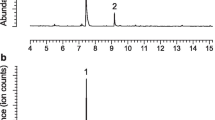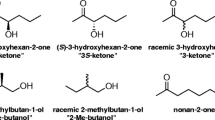Abstract
Cerambycid beetles of the subfamily Lamiinae use male-produced aggregation-sex pheromones that are attractive to both sexes. Terpenoid pheromones have been identified from species in the tribes Acanthoderini and Acanthocinini native to North and South America, comprised of (E)-6,10-dimethyl-5,9-undecadien-2-one (geranylacetone), the structurally related 6-methylhept-5-en-2-one (sulcatone), and/or specific enantiomers or nonracemic ratios of enantiomers of the related compounds (E)-6,10-dimethyl-5,9-undecadien-2-ol (fuscumol), its acetate ester, (E)-6,10-dimethyl-5,9-undecadien-2-yl acetate (fuscumol acetate), and 6-methylhept-5-en-2-ol (sulcatol). Here, we present new information about the chemical ecology of six acanthoderine and acanthocinine species native to the eastern USA. The pheromone of Astyleiopus variegatus (Haldeman) previously was identified as a blend of (S)-fuscumol and (S)-fuscumol acetate, and we report here that geranylacetone is a synergistic component. Males of Aegomorphus modestus (Gyllenhal), Lepturges angulatus (LeConte), and Lepturges confluens (Haldeman) were found to produce similar blends composed of the enantiomers of fuscumol acetate and geranylacetone, whereas males of Astylidius parvus (LeConte) and Sternidius alpha (Say) produced both enantiomers of fuscumol together with (R)-fuscumol acetate and geranylacetone. Field experiments with synthesized chemicals revealed that species with similar pheromone composition nevertheless differed in their responses to individual components, and to various blends of components, and in how attraction was influenced by chemicals that were pheromone components of other species. Sulcatone and/or sulcatol antagonized attraction of some species to pheromones of the geranylacetone class, suggesting that there is an adaptive advantage in an ability to detect these heterospecific compounds, such as in avoiding cross attraction to other cerambycid species, as yet unknown, that use pheromones composed of both chemical classes.




Similar content being viewed by others
References
Borden JH, Handley JR, McLean JA, Silverstein RM, Chong L, Slessor KN, Johnston BD, Schuler HR (1980) Enantiomer-based specificity in pheromone communication by two sympatric Gnathotrichus species (Coleoptera: Scolytidae). J Chem Ecol 2:445–456
Fonseca MG, Vidal DM, Zarbin PHG (2010) Male-produced sex pheromone of the cerambycid beetle Hedypathes betulinus: chemical identification and biological activity. J Chem Ecol 36:1132–1139
Hanks LM, Millar JG (2013) Field bioassays of cerambycid pheromones reveal widespread parsimony of pheromone structures, enhancement by host plant volatiles, and antagonism by components from heterospecifics. Chemoecol 23:21–44
Hanks LM, Millar JG (2016) Sex and aggregation-sex pheromones of cerambycid beetles: basic science and practical applications. J Chem Ecol 42:631–654
Hanks LM, Millar JG, Mongold-Diers JA, Wong JCH, Meier LR, Reagel PF, Mitchell RF (2012) Using blends of cerambycid beetle pheromones and host plant volatiles to simultaneously attract a diversity of cerambycid species. Can J For Res 42:1050–1059
Hanks LM, Reagel PF, Mitchell RF, Wong JCH, Meier LR, Silliman CA, Graham EE, Striman BL, Robinson KP, Mongold-Diers JA, Millar JG (2014) Seasonal phenology of the cerambycid beetles of east-Central Illinois. Ann Entomol Soc Am 107:211–226
Hanks LM, Mongold-Diers JA, Atkinson TH, Fierke MK, Ginzel MD, Graham EE, Poland TM, Richards AB, Richardson ML, Millar JG (2018) Blends of pheromones, with and without host plant volatiles, can attract multiple species of cerambycid beetles simultaneously. J Econ Entomol 111:716–724
Hanks LM, Mongold-Diers JA, Mitchell RF, Zou Y, Wong JCH, Meier LR, Johnson TD, Millar JG (2019) The role of minor pheromone components in segregating 14 species of longhorned beetles (Coleoptera: Cerambycidae) of the subfamily Cerambycinae. J Econ Entomol 112:2236–2252
Heath RR, Mitchell ER, Tovar JC (1990) Effect of release rate and ratio of (Z)-11-hexadecen-1-ol from synthetic pheromone blends on trap capture of Heliothis subflexa (Lepidoptera: Noctuidae). J Chem Ecol 16:1259–1268
Hughes GP, Zou Y, Millar JG, Ginzel MD (2013) (S)-fuscumol and (S)-fuscumol acetate produced by a male Astyleiopus variegatus (Coleoptera: Cerambycidae). Can Entomol 145:1–6
Hughes GP, Meier LR, Zou Y, Millar JG, Hanks LM, Ginzel MD (2016) Stereochemistry of fuscumol and fuscumol acetate influences attraction of longhorned beetles (Coleoptera: Cerambycidae) of the subfamily Lamiinae. Environ Entomol 45:1271–1275
Lingafelter SW (2007) Illustrated key to the longhorned wood-boring beetles of the eastern United States. Special publication no. 3. Coleopterists Society, North Potomac, p 206
Linsley EG, Chemsak JA (1995) The Cerambycidae of North America, part VII, no. 2: taxonomy and classification of the subfamily Lamiinae, tribes Acanthocinini through Hemilophini. Univ Calif Publ Entomol 114:1–292
Meier LR, Zou Y, Millar JG, Mongold-Diers JA, Hanks LM (2016) Synergism between enantiomers creates species-specific pheromone blends and minimizes cross-attraction for two species of cerambycid beetles. J Chem Ecol 42:1181–1192
Meier LR, Millar JG, Mongold-Diers JA, Hanks LM (2019) (S)-Sulcatol is a pheromone component for two species of cerambycid beetles in the subfamily Lamiinae. J Chem Ecol 45:447–454
Millar JG, Hanks LM (2017) Chemical ecology of cerambycids. In: Wang Q (ed) Cerambycidae of the world: biology and pest management. CRC Press/Taylor & Francis, Boca Raton, pp 161–208
Millar JG, Mitchell RF, Mongold-Diers JA, Zou Y, Bográn CE, Fierke MK, Ginzel MD, Johnson CW, Meeker JR, Poland TM, Ragenovich IR, Hanks LM (2018) Identifying possible pheromones of cerambycid beetles by field testing known pheromone components in four widely separated regions of the United States. J Econ Entomol 111:252–259
Mitchell RF, Graham EE, Wong JCH, Reagel PF, Striman BL, Hughes GP, Paschen MA, Ginzel MD, Millar JG, Hanks LM (2011) Fuscumol and fuscumol acetate are general attractants for many species of cerambycid beetles in the subfamily Lamiinae. Entomol Exp Appl 141:71–77
Monné MA, Hovore FT (2005) Checklist of the Cerambycidae (Coleoptera) of the Western hemisphere. BioQuip, Rancho Dominguez
Quinn GP, Keough MJ (2002) Experimental design and data analysis for biologists. Cambridge University Press, Cambridge, UK
Ryall K, Silk P, Webster RP, Gutowski JM, Meng Q, Li Y, Gao W, Fidgen J, Kimoto T, Scarr T, Mastro V, Sweeney JD (2015) Further evidence that monochamol is attractive to Monochamus (Coleoptera: Cerambycidae) species, with attraction synergised by host plant volatiles and bark beetle (Coleoptera: Curculionidae) pheromones. Can Entomol 147:564–579
SAS Institute (2011) SAS/STAT 9.3 user's guide. SAS Institute Inc., Cary
Silk PJ, Sweeney J, Wu J, Price J, Gutowski JM, Kettela EG (2007) Evidence for a male-produced pheromone in Tetropium fuscum (F.) and Tetropium cinnamopterum (Kirby) (Coleoptera: Cerambycidae). Naturwissenschaften 94:697–701
Silva WD, Zou Y, Hanks LM, Bento JMS, Millar JG (2019) Enantiomers of fuscumol acetate comprise the aggregation-sex pheromone of the south American cerambycid beetle Psapharochrus maculatissimus, and likely pheromones of the cerambycids Eupromerella plaumanni and Hylettus seniculus. Entomol Exp Appl 167:915–921
Sokal RR, Rohlf FJ (1995) Biometry, 3rd edn. WH Freeman and Co, New York
Švácha P, Lawrence JF (2014) Chapter 2.4 Cerambycidae Latreille, 1802, pp. 77–177. In: Leschen RAB, Beutel RG (eds) handbook of zoology: Arthropoda: Insecta: Coleoptera, beetles. Vol. 3: morphology and systematics (Phytophaga), Walter de Gruyter, Berlin/Boston
Sweeney JD, Silk PJ, Gutowski JM, Wu J, Lemay MA, Mayo PD, Magee DI (2010) Effect of chirality, release rate, and host volatiles on response of Tetropium fuscum (F.), Tetropium cinnamopterum Kirby, and Tetropium castaneum (L.) to the aggregation pheromone, fuscumol. J Chem Ecol 36:1309–1321
Vidal DM, Fonseca MG, Zarbin PH (2010) Enantioselective synthesis and absolute configuration of the sex pheromone of Hedypathes betulinus (Coleoptera: Cerambycidae). Tetrahedron Lett 51:6704–6706
Acknowledgements
We thank Jodie A. Ellis for assistance with laboratory work. We also thank S. Buck and the University of Illinois Committee on Natural Areas for access to field sites. This research was supported by a grant to L.M.H. from The Alphawood Foundation of Chicago, and grants to J.G.M. and L.M.H. from the United Stated Department of Food and Agriculture, National Institute of Food and Agriculture (USDA-NIFA, grant numbers 2012-67013-19303 and 2015-67013-23173), and USDA-Animal and Plant Health Inspection Service grant #15-8130-1422-CA.
Author information
Authors and Affiliations
Corresponding author
Electronic supplementary material
ESM 1
(DOCX 19 kb)
Rights and permissions
About this article
Cite this article
Meier, L.R., Zou, Y., Mongold-Diers, J.A. et al. Pheromone Composition and Chemical Ecology of Six Species of Cerambycid Beetles in the Subfamily Lamiinae. J Chem Ecol 46, 30–39 (2020). https://doi.org/10.1007/s10886-019-01128-7
Received:
Revised:
Accepted:
Published:
Issue Date:
DOI: https://doi.org/10.1007/s10886-019-01128-7




